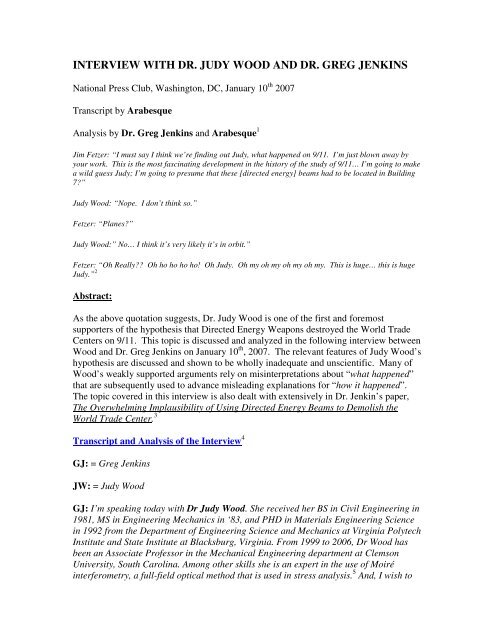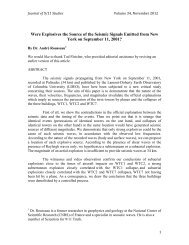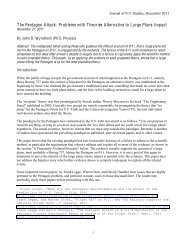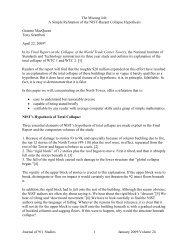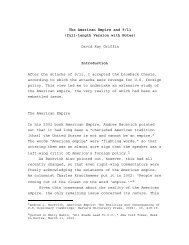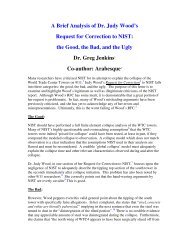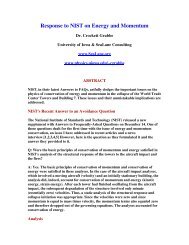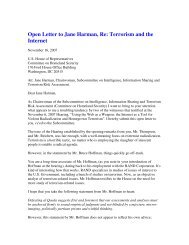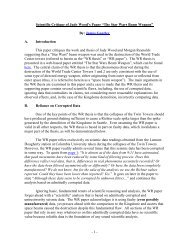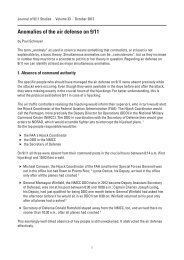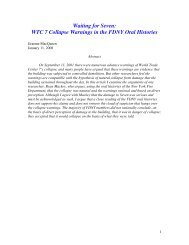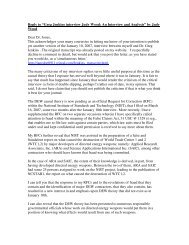interview with dr. judy wood and dr. greg jenkins - Journal of 9/11 ...
interview with dr. judy wood and dr. greg jenkins - Journal of 9/11 ...
interview with dr. judy wood and dr. greg jenkins - Journal of 9/11 ...
Create successful ePaper yourself
Turn your PDF publications into a flip-book with our unique Google optimized e-Paper software.
INTERVIEW WITH DR. JUDY WOOD AND DR. GREG JENKINS<br />
National Press Club, Washington, DC, January 10 th 2007<br />
Transcript by Arabesque<br />
Analysis by Dr. Greg Jenkins <strong>and</strong> Arabesque 1<br />
Jim Fetzer: “I must say I think we’re finding out Judy, what happened on 9/<strong>11</strong>. I’m just blown away by<br />
your work. This is the most fascinating development in the history <strong>of</strong> the study <strong>of</strong> 9/<strong>11</strong>… I’m going to make<br />
a wild guess Judy; I’m going to presume that these [directed energy] beams had to be located in Building<br />
7?”<br />
Judy Wood: “Nope. I don’t think so.”<br />
Fetzer: “Planes?”<br />
Judy Wood:” No… I think it’s very likely it’s in orbit.”<br />
Fetzer: “Oh Really?? Oh ho ho ho ho! Oh Judy. Oh my oh my oh my oh my. This is huge… this is huge<br />
Judy.” 2<br />
Abstract:<br />
As the above quotation suggests, Dr. Judy Wood is one <strong>of</strong> the first <strong>and</strong> foremost<br />
supporters <strong>of</strong> the hypothesis that Directed Energy Weapons destroyed the World Trade<br />
Centers on 9/<strong>11</strong>. This topic is discussed <strong>and</strong> analyzed in the following <strong>interview</strong> between<br />
Wood <strong>and</strong> Dr. Greg Jenkins on January 10 th , 2007. The relevant features <strong>of</strong> Judy Wood’s<br />
hypothesis are discussed <strong>and</strong> shown to be wholly inadequate <strong>and</strong> unscientific. Many <strong>of</strong><br />
Wood’s weakly supported arguments rely on misinterpretations about “what happened”<br />
that are subsequently used to advance misleading explanations for “how it happened”.<br />
The topic covered in this <strong>interview</strong> is also dealt <strong>with</strong> extensively in Dr. Jenkin’s paper,<br />
The Overwhelming Implausibility <strong>of</strong> Using Directed Energy Beams to Demolish the<br />
World Trade Center. 3<br />
Transcript <strong>and</strong> Analysis <strong>of</strong> the Interview 4<br />
GJ: = Greg Jenkins<br />
JW: = Judy Wood<br />
GJ: I’m speaking today <strong>with</strong> Dr Judy Wood. She received her BS in Civil Engineering in<br />
1981, MS in Engineering Mechanics in ‘83, <strong>and</strong> PHD in Materials Engineering Science<br />
in 1992 from the Department <strong>of</strong> Engineering Science <strong>and</strong> Mechanics at Virginia Polytech<br />
Institute <strong>and</strong> State Institute at Blacksburg, Virginia. From 1999 to 2006, Dr Wood has<br />
been an Associate Pr<strong>of</strong>essor in the Mechanical Engineering department at Clemson<br />
University, South Carolina. Among other skills she is an expert in the use <strong>of</strong> Moiré<br />
interferometry, a full-field optical method that is used in stress analysis. 5 And, I wish to
extend my thanks to Dr Judy Wood for taking time out <strong>of</strong> her schedule for this <strong>interview</strong>,<br />
<strong>and</strong> on behalf <strong>of</strong> our ragtag b<strong>and</strong> called DC9<strong>11</strong>Truth 6 I welcome you.<br />
JW: Thank you.<br />
GJ: Well, thank you. I guess the first question is: you have come up <strong>with</strong> some ideas<br />
regarding space-based weapons <strong>and</strong> the demolition <strong>of</strong> the World Trade Center Towers,<br />
<strong>and</strong> I was wondering if you could give us an overview <strong>of</strong> the proposed types <strong>of</strong> weapons<br />
that could be used for such a thing.<br />
JW: Uh… We haven’t got into listing them yet—Just Energy Weapons.<br />
GJ: In what form?<br />
JW: (stuttering hesitantly) Uh… I don’t think we even need to define it.<br />
Evasion #1:<br />
This is analogous to speculating that ‘people caused the towers to collapse,’ <strong>and</strong> then<br />
claiming ‘we don’t need to define who those people were’! Since the term ‘people’ is so<br />
general, we are left <strong>with</strong> a theory that is hopelessly vague. Effectively, by evading this<br />
basic question Wood has left little room for critical debate or analysis. Similarly, the<br />
term ‘Energy Weapons’ is also vague—resulting in a speculative theory devoid <strong>of</strong><br />
substance.<br />
The question: “in what form [<strong>of</strong> Energy]” is fundamentally basic. Energy comes in a<br />
huge variety <strong>of</strong> forms: plasmas, nuclear, electric current, electromagnetic radiation (radio<br />
waves, microwaves, laser beams, x-rays, etc.), ion & neutral particle beams, electron &<br />
proton beams, chemical reactions, kinetic energy weapons, etc. Leaving the type <strong>of</strong><br />
‘energy’ undefined essentially leaves us <strong>with</strong> no theory at all. As for types <strong>of</strong> beams,<br />
“there are only two …those that have mass (particle beams such as protons, ions, neutral<br />
atoms, or electrons) <strong>and</strong> those that do not have mass (photons).” 7<br />
JW [continuing]: What we did was assemble all the pictures—evidence that we trusted,<br />
<strong>and</strong> just going through the evidence—just looking at it. At that point what motivated this<br />
paper was…wait—we’ve been told this story, that story—let’s wipe the slate clean <strong>and</strong><br />
start over. Let’s see what evidence we do believe instead <strong>of</strong> relying on this rumor mill.<br />
We’re told about molten metal that nobody has ever seen pictures <strong>of</strong>—these rumors <strong>of</strong><br />
molten metal.<br />
Misleading Argument #1:<br />
This statement about molten metal is misleading for several reasons. Appendix C <strong>of</strong> the<br />
FEMA report noted that there was “severe corrosion” <strong>of</strong> “structural steel members”<br />
<strong>and</strong> independent investigators observed “intergranular melting” <strong>of</strong> “steel” from ground
zero. 8 Although there do not appear to be many photographs <strong>of</strong> running molten steel,<br />
there are many eyewitness statements. 9 There are also photographs <strong>of</strong> red-orange metal, 10<br />
<strong>and</strong> several photographs <strong>of</strong> previously molten metal. <strong>11</strong> New studies by Dr. Steven Jones<br />
reveal thermate compounds in iron-rich metallic spheres from the dust at ground zero.<br />
These studies indicate that many <strong>of</strong> the dust samples had high percentages <strong>of</strong> molten<br />
iron in them. Jones’ analysis <strong>of</strong> iron rich spheres is corroborated by <strong>of</strong>ficial USGS<br />
studies that claim that these spheres are “frequently seen”. 12 Especially noteworthy is a<br />
sample <strong>of</strong> dust taken from the 4 th floor <strong>of</strong> an apartment about 100 Yards away from South<br />
Tower. This sample also contained metallic spheres, indicating that there was molten<br />
metal during the collapse <strong>and</strong> that this material was ejected a far distance away from the<br />
towers. 13 This data further supports Jones’ hypothesis that thermate <strong>and</strong> possibly variants<br />
were used in the destruction <strong>of</strong> the World Trade Center Towers. 14<br />
JW [continuing]:Let’s see if we can find any pictures <strong>of</strong> it. Let’s see what we can see.<br />
And so I started looking through [many] pictures. What were they telling us—what’s the<br />
evidence? And what categories <strong>of</strong> information? And you start putting these categories <strong>of</strong><br />
information together <strong>and</strong> it turns the building in one direction <strong>and</strong> eliminating various<br />
other possibilities.<br />
GJ: No matter what the beam that is used in this situation, will involve—I guess the term<br />
you use is ‘dustification’ <strong>of</strong> metal…<br />
JW: I thought I’d invent a new word.<br />
GJ: Might as well, right?<br />
JW: Po<strong>of</strong>!<br />
GJ: …or the vaporization <strong>of</strong> the metal in the towers, one or the other. Have you had, do<br />
you have any energy calculations at all to get a scale for what is involved for doing<br />
that?<br />
JW: Yea, but [stuttering] we don’t need to get distracted by those values.<br />
Evasion #2:<br />
No scientist or physicist would ever consider a simple energy calculation a distraction. As<br />
stated later in the <strong>interview</strong>, “Conservation <strong>of</strong> Energy is NOT a distraction!” It is a<br />
basic tenet <strong>of</strong> physics that should be taken very seriously—not disregarded as a<br />
‘distraction’. In actual fact, the entire directed energy hypothesis is a distraction until it<br />
can ad<strong>dr</strong>ess this serious problem: “The energy required to vaporize all the steel from both<br />
towers was pumped into the towers during the collapse time, approximately 10 seconds…<br />
is over 5 times the total power output <strong>of</strong> the entire earth including all carbon<br />
combustion, nuclear power, wind power, hy<strong>dr</strong>oelectric power, etc. This is <strong>with</strong> no loss.” 15
JW [continuing]: If you look at the pictures, if you look at the scrap pile that when it<br />
was all done <strong>with</strong>, is there any question that the building was pulverized?<br />
Misleading Argument #2:<br />
Pulverization is also characteristic <strong>of</strong> controlled demolition because “explosives powerful<br />
enough to slice steel will pulverize concrete <strong>and</strong> most other non-metallic substances into<br />
tiny particles.” 16 According to first responders at ground zero, there did appear to be<br />
substantial pulverization. 17 However, Judy Wood argues that most <strong>of</strong> the building from<br />
the towers never hit the ground. In Wood’s interpretation, the two towers were almost<br />
entirely turned to dust including most <strong>of</strong> the steel. Her claim that not enough debris was<br />
visible on the surface at ground zero is not supported by any quantitative analysis. Her<br />
argument that most <strong>of</strong> the steel turned to dust is based on misinterpretations <strong>of</strong><br />
photographs—an analysis that is inherently problematic since pictures only show the<br />
debris on the surface. Analysis <strong>of</strong> the sublevel collapses accounts for a huge percentage<br />
<strong>of</strong> the debris from the entire WTC complex. Most <strong>of</strong> the debris is not visible in many<br />
pictures since it is located in piles, both above <strong>and</strong> below ground. 18 In comparison,<br />
WTC7’s debris pile was relatively small in height; this is typical for controlled<br />
demolition.<br />
GJ: Well I do have some questions… I’ve come up <strong>with</strong> an energy scale for the problem.<br />
If you use, like, say, a photon beam—a laser beam <strong>of</strong> some kind, you run into some<br />
problems, namely, the amount <strong>of</strong> energy required to evaporate the steel in the towers<br />
is…<br />
JW: Wait, you’re specifying evaporation?<br />
Evasion #3:<br />
Judy Wood interrupts the question before it is completed <strong>and</strong> changes the subject to<br />
avoid discussing this major problem <strong>with</strong> her hypothesis. [Read also evasion #2.] 19<br />
GJ: Sure.<br />
JW: What about dustification? Is that what we’re talking about?<br />
GJ: You want to talk about dustification?<br />
JW: Well, pulverizing the building is turning… the building contents into Nano-dust,<br />
we’ll call it.<br />
Comment: Wood’s statement that the WTC was turned into “nano-dust” has no<br />
evidential basis in reality. Nano used in the scientific vernacular is defined as the number<br />
10 -9 . Debris is considered to be dust when the particle sizes are between roughly 1 <strong>and</strong>
100 microns (10 -6 m = 1 micron). Debris which is smaller than 1 micron is generally<br />
considered to be an aerosol. The size <strong>of</strong> atoms is roughly 1 nanometer (10 -9 m). Any<br />
reasonable translation <strong>of</strong> the language Judy Wood is applying here leaves the listener to<br />
conclude that Dr. Wood’s opinion is that the WTC towers was dissociated into individual<br />
atoms! There are a multitude <strong>of</strong> reasons this is an absurd claim. One strong argument<br />
against this argument is that the power required to atomize all the steel, concrete, <strong>and</strong><br />
building contents would be much larger than 5 times the global power harnessed by<br />
human beings. Wood’s statement is also not supported by <strong>of</strong>ficial USGS studies. See<br />
Misleading Argument #9 for more discussion <strong>of</strong> this.<br />
GJ: Okay. Right now, I don’t know… has this been done in the laboratory? Has<br />
anything been done that would turn steel into dust?<br />
JW: Uh-huh.<br />
Comment: These tests by Wood appear to have been done in her imagination—she does<br />
not name any credible experiments which can turn steel into dust. Wood describes this<br />
undemonstrated process as “dustification”.<br />
GJ: What?<br />
JW: Various types <strong>of</strong> energy beams.<br />
Comment: Again, Wood is not specific here. Even worse, the specified experiment<br />
mentioned below is incapable <strong>of</strong> turning steel into dust.<br />
GJ: What kinds <strong>of</strong> energy beams?<br />
JW: Well let’s see… you put something in your microwave oven <strong>and</strong> leave it on there<br />
extra long <strong>and</strong> see what happens to it.<br />
Misleading Argument #3:<br />
Microwaves will never turn steel into dust in a microwave oven; especially since the<br />
reflectivity <strong>of</strong> steel is well over 99%. 20 An essential component <strong>of</strong> the scientific method is<br />
that a hypothesis can be tested <strong>with</strong> experiments. If a theory can not be tested it is called<br />
non-falsifiable <strong>and</strong> it is not considered a scientific hypothesis. 21 In other words, if Judy<br />
Wood can not suggest experiments to test her theory, she will never be able to prove it.<br />
She might as well argue that invisible wingless flying ducks destroyed the World Trade<br />
Center.<br />
GJ: That’s food. That’s not metal.<br />
JW: Or something else.
GJ: If you put metal in a microwave it will reflect <strong>of</strong>f <strong>of</strong> it.<br />
JW: Hey! I’ve been trying a fork in there. I know you’re not supposed to, but I wanted<br />
someone else to do it, to see what happens.<br />
Comment: Judy Wood claimed that she had performed experiments which can turn steel<br />
into dust. A microwave oven will never turn a fork into dust.<br />
GJ: Yes, it’s kinda fun. Also, if you burn a disc, like a CD or something, stick it in the<br />
microwave. It makes a nice little show for you, so you might try that. It’s kinda a fun<br />
thing to do. 22 But, the thing is, I don’t know <strong>of</strong> a way to dustify steel in any situation,<br />
<strong>and</strong>…<br />
JW: [stuttering] Let’s talk about physical principles. If you heat steel… some type <strong>of</strong>…<br />
[a] particular kind <strong>of</strong> element, <strong>and</strong> heat it <strong>with</strong> a particular vapor pressure, it evaporates.<br />
GJ: It evaporates, yes.<br />
JW: So if you have enough temperature, enough energy, you can quickly put a lot <strong>of</strong><br />
energy into something—it’ll go “po<strong>of</strong>”.<br />
GJ: It will evaporate, yes. Correct.<br />
JW: And if you do that to one surface, maybe the surface right below there, it doesn’t<br />
necessarily do the same thing to [it], because there’s a different process going on from<br />
the direct hit <strong>and</strong> the indirect hit.<br />
GJ: That depends on the heat conduction <strong>of</strong> what you’re trying to evaporate.<br />
JW: No. not heat conduction! We’re talking about an effect on a molecule. Why does the<br />
paper towel in your microwave not burn when water heats up?<br />
Comment: Judy Wood appears to try to convey that if ‘some kind <strong>of</strong> energy’ was applied<br />
to a material quickly, then only a local area <strong>of</strong> the material may be rapidly heated. This is<br />
true, but it depends upon the heat conduction <strong>of</strong> the material you are using. That is, if the<br />
time scale in which you pump in the energy is slow compared to the time it takes the heat<br />
to be wicked away via heat conduction, this effect will not occur. If you pump in heat fast<br />
enough compared to the time scale associated <strong>with</strong> heat conduction, you will only locally<br />
heat the material. 23<br />
GJ: Because it doesn’t have water in it.<br />
JW: Right. So the energy does one thing to paper, <strong>and</strong> does another thing to water.
GJ: That’s because microwaves are absorbed by water, <strong>and</strong> the paper in the towel is not<br />
absorbed by water. 24 It has to do <strong>with</strong> the resonant energy <strong>of</strong> water. 25<br />
JW: So if you have some kind <strong>of</strong> energy you can put into a particular element… that<br />
excites that particular element… 26<br />
GJ: If you excite an element you’re talking on the order <strong>of</strong> the scales <strong>of</strong> eV to excite the<br />
electrons. If you’re talking about a crystal, then you’re talking about the bonding<br />
energies associated <strong>with</strong> that crystal. So if you’re talking about steel… 27<br />
Evasion #4:<br />
Judy Wood once again interrupts <strong>and</strong> changes the subject after the problem <strong>of</strong> turning<br />
steel into dust returns.<br />
JW: [stuttering] Hang on, hang on. There’s a slide that presents this information that<br />
I’ve started using. First you figure out what happened,<br />
Comment: Agreed. This <strong>of</strong> course assumes that we don’t first start <strong>with</strong> misleading<br />
interpretations/explanations that obfuscate what happened. There are many examples<br />
<strong>of</strong> this kind <strong>with</strong>in this <strong>interview</strong>. We are doubly confused when presented <strong>with</strong><br />
misleading versions <strong>of</strong> what had happened <strong>and</strong> how it happened.<br />
JW [continuing]: then you figure out how it happened, then maybe why it happened, then<br />
who done it. But you’ve gotta start <strong>and</strong> do it in that order. You’ve got to figure out what<br />
happened. What happened doesn’t depend on what you know about, <strong>and</strong> here’s the<br />
example I gave in Seattle. Let’s say you know, the slingshot, the BB gun, <strong>and</strong>… a<br />
firecracker. That’s all you know about. So you can only pick from those if you’re<br />
going to describe what happened to the Twin Towers. Does that make sense?<br />
Misleading Argument #4:<br />
This is a straw-man argument. The Scientific method does not ignore possibilities or<br />
necessarily begin <strong>with</strong> pre-determined conclusions as suggested by Judy Wood. It<br />
observes phenomenon, determines a hypothesis, <strong>and</strong> most crucially—tests the hypothesis<br />
<strong>with</strong> experiments. Clearly, the concept <strong>of</strong> falsifiable experiments has been ignored by<br />
Wood. Also characteristic <strong>of</strong> the scientific method is the rejection <strong>of</strong> theories when they<br />
are proven false <strong>with</strong> experiments. This <strong>of</strong> course can’t happen when a theory is unable<br />
to be tested.<br />
GJ: No. I don’t underst<strong>and</strong>.<br />
JW: If you don’t know about it, it doesn’t mean it didn’t happen.
Misleading Argument #5 (see also #4):<br />
This statement is a straw-man argument. Just because we don’t know about it doesn’t<br />
mean it did happen. What is relevant is that the scientific method is used to determine a<br />
hypothesis—any hypothesis, <strong>and</strong> then test it <strong>with</strong> experiments. As soon as we start to<br />
debate things that can’t be proven we are no longer dealing <strong>with</strong> science—we are in the<br />
realm <strong>of</strong> opinion, faith, <strong>and</strong> unanswerable speculation.<br />
JW: If I can figure out what happened first, then how it happened is down the road.<br />
GJ: Ok, can we talk about your analysis on what happened?<br />
JW: Ok. That’s really where we are right now. We don’t know the serial number on the<br />
gizmo that was used, or was it something light came <strong>of</strong>f <strong>of</strong>…<br />
Evasion #5<br />
Judy Wood will have to figure out the “serial number on the gizmo” or demonstrate an<br />
experiment to prove her hypothesis. She has provided neither, <strong>and</strong> her theory remains<br />
non-falsifiable. Indeed, her hypothesis is too vague to test as the form <strong>of</strong> energy<br />
employed by the proposed ‘gizmo’ is left unspecified. This leaves us a theory that is illdefined<br />
as well as non-falsifiable. Even more suspect is the fact that Wood has not even<br />
proven her case for “what first happened” before determining “how it happened”.<br />
GJ: Okay. So, one thing that is puzzling to me that you had calculated the ratio <strong>of</strong> a<br />
building that was the Kingdome, right? And you looked at the ratio <strong>of</strong> before collapse<br />
height to the ratio <strong>of</strong> after collapse height…<br />
JW: Not the height—the mass. These are approximate ballpark numbers…<br />
Comment: This statement by Wood is nonsensical; she does not analyze the before <strong>and</strong><br />
after collapse mass <strong>of</strong> the Kingdome as they are obviously going to be the same amount.<br />
She should be able to remember simple details such as these as they are an important part<br />
<strong>of</strong> her theory. Since this <strong>interview</strong> in January, she has failed to ad<strong>dr</strong>ess any <strong>of</strong> these<br />
legitimate criticisms <strong>and</strong> has repeated arguments <strong>and</strong> misinterpretations <strong>of</strong> evidence that<br />
have been demonstrated to be misleading.<br />
GJ: You’ve come up <strong>with</strong> 12%, or something like that, for the before <strong>and</strong> after collapse<br />
height.<br />
JW: Uh… [trying to remember] it’s been a long time since I looked at those numbers—<br />
the Kingdome was 30 feet, <strong>and</strong> I think it was something like 250, originally?
GJ: Well, I have the number, <strong>and</strong> you quote on your website as it being… it could be 12<br />
point something percent, but it was about 12%.<br />
JW: That page is in the most rough state possible. You can probably see it’s half done,<br />
we haven’t really touched that really since I first started posting it, so I’m not really<br />
familiar <strong>with</strong> the numbers now because it’s been so long…<br />
GJ: Okay. That’s fair enough.<br />
JW: I haven’t done the triple, double checking, but I’ve looked at general trends, <strong>and</strong> the<br />
general trends—you have a 30 times difference in potential energy. That was the biggest<br />
thing I’m focusing on. Now looking at the rubble pile when you’re all done <strong>with</strong>, let’s<br />
look at the pictures. You know, exact numbers—who cares? Let’s look at the pictures.<br />
Misleading Argument #6:<br />
Wood uses an unreliable scaling method to determine how much rubble has been left at<br />
the WTC towers <strong>and</strong> “<strong>of</strong>fers no analytical measurement <strong>of</strong> the debris present after the<br />
WTC tower collapse. Instead, she vaguely <strong>and</strong> non-quantitatively refers to pictures where<br />
it is speculatively assumed to be self evident.” 28<br />
Seismograph readings were used by Dr. Wood as evidence that much <strong>of</strong> the debris from<br />
the towers never hit the ground. She used an erroneous scaling argument in which the<br />
Richter scale reading measured from the collapse <strong>of</strong> the Kingdome is compared directly<br />
to the potential energy <strong>of</strong> the Kingdome. Based upon this analysis, she then scales the<br />
potential energy to obtain a hypothetical Richter scale reading. This hypothetical Richter<br />
scale reading is significantly larger than that actually measured from either WTC Tower<br />
collapses.<br />
Her analysis is pr<strong>of</strong>oundly flawed. Consider the following example. The M L (similar to<br />
Richter scale reading) reported for the North Tower is 2.3. The M L from the raw<br />
amplitude seismograph readings for WTC 7 is 1.0. Even though the potential energy <strong>of</strong><br />
the North Tower compared to WTC 7 was about 5 times larger, the energy derived from<br />
the Richter scale measurements is 87 times larger. It would be absurd to conclude from<br />
this that most <strong>of</strong> the debris from Building 7 never hit the ground. 29<br />
JW [continuing]: You have these little people, look like tiny ants, this huge outer edge <strong>of</strong><br />
the Kingdome…<br />
GJ: Correct.<br />
JW: …<strong>and</strong>, if you recall at the World Trade Center, when they were looking for<br />
survivors <strong>and</strong> they had the rescue workers—they worked horizontally, And they were<br />
pulled down. They didn’t have to climb up over, you know, many times their height.
GJ: So in that ratio, if you do look at the numbers <strong>and</strong> you use your analysis for the<br />
Kingdome…<br />
JW: Which numbers?<br />
GJ: On your website you had stated a certain average height <strong>of</strong> the Kingdome before<br />
collapse, <strong>and</strong> a certain height…<br />
JW: The center <strong>of</strong> it or just the average shape? And it really would have been lower if<br />
you looked at the actual… I was looking at easy to find numbers, but the error would be<br />
in favor <strong>of</strong>, it would make a thirty times bigger number.<br />
GJ: Okay it would make it bigger than your 12%<br />
JW: Because I have it that it’s too high already.<br />
GJ: I see.<br />
JW: Because the ro<strong>of</strong> is very thin.<br />
GJ: Yes, it is.<br />
JW: And so if I’m saying just from the shape, you have the cylinder <strong>with</strong> the spherical<br />
cap on it, <strong>and</strong> I’m saying it all is the same weight per volume. And the top part’s really<br />
thin. You’re giving it too much benefit, so that’s making the center <strong>of</strong> it too high…<br />
GJ: Correct, <strong>and</strong> I agree <strong>with</strong> that, I definitely agree that’s a good way to look at it.<br />
JW: The error is in… the 30 is a low number.<br />
GJ: Right. Now, on the rim <strong>of</strong> that, where you take the after-collapse height, the rim is<br />
mainly structural concrete.<br />
JW: I’m not talking about the whole volume <strong>of</strong> the thing, I’m talking about… there’s<br />
quite a lot <strong>of</strong> places where somebody measured that. I didn’t measure it. According to<br />
the reference I provided, that’s the number they gave. Then I look at the comparative<br />
height. The towers were a whole lot taller to begin <strong>with</strong>. About four times or so?<br />
GJ: The towers were <strong>11</strong>0 floors, roughly 12 feet, <strong>and</strong> so they were about 1350 feet tall.<br />
JW: 1368.<br />
GJ: Yes.<br />
JW: I don’t remember exactly the equivalent in stories <strong>of</strong> the other one…
GJ: Well, if you take the collapse ratio <strong>and</strong> say it’s 12% <strong>of</strong> the height, then it would be 13<br />
or 14 floors you had come up <strong>with</strong> on the debris height. That’s what you did on your<br />
website.<br />
JW: I haven’t looked over that page in a while.<br />
GJ: I’m just trying to refresh your memory.<br />
JW: I thought I’d made some equivalent <strong>of</strong> how many floors the 250 feet was worth at<br />
the Kingdome. But in any case, I said that 13 or 14 floors… if you start looking around<br />
the site, is there anything that’s that tall?<br />
GJ: No, but it didn’t collapse in on its footprint either.<br />
JW: True. Why didn’t it?<br />
GJ: Because it didn’t. Where did it collapse? It collapsed in a radius six times its<br />
footprint.<br />
JW: Six times its footprint?<br />
Misleading Argument #7:<br />
Wood’s analysis is flawed since the WTC towers collapsed in a radius <strong>of</strong> about six times<br />
its footprint. In contrast, the Kingdome’s debris collapsed <strong>with</strong>in its footprint. 30 As a<br />
larger footprint would mean a larger distribution <strong>of</strong> debris, it would not be accurate to<br />
compare the example <strong>of</strong> the Kingdome to the WTC Towers. Judy Wood never<br />
acknowledges this point in the <strong>interview</strong>, <strong>and</strong> evades questions that relate to this fact<br />
repeatedly. As well, much <strong>of</strong> the debris from the WTC collapsed into the sublevels—as<br />
is typical in controlled demolition.<br />
GJ: Yes.<br />
JW: I think if you want to count its material it’s probably like… a million times its<br />
footprint. It went in the upper atmosphere. You know, where do you stop counting it? Is<br />
it a mile away—the dust…?<br />
Evasion #6:<br />
Wood irksomely evades discussion <strong>of</strong> the debris field [see misleading argument #6 <strong>and</strong><br />
#7] <strong>with</strong> her unproven interpretation/hypothesis that debris went into the ‘upper<br />
atmosphere’ during the collapse [misleading argument #8].<br />
Misleading Argument #8:
There is no evidence that any significant amount <strong>of</strong> dust “went into the upper<br />
atmosphere” during the collapse <strong>of</strong> the WTC towers as Wood claims, <strong>and</strong> she makes use<br />
<strong>of</strong> misleading interpretations <strong>of</strong> photos to support this theory <strong>and</strong> also misrepresents<br />
<strong>of</strong>ficial USGS studies. 31<br />
GJ: You can take any kind <strong>of</strong> distribution you want. The rough radius roughly makes an<br />
area six times bigger, if you look at the debris coming down <strong>of</strong>f <strong>of</strong> that building.<br />
Comment: A scientist can speak <strong>of</strong> ‘distributions’ <strong>and</strong> know what another scientist is<br />
saying. In this case, a distribution is the precise form that the debris may be dispersed.<br />
For instance, a Gaussian distribution <strong>of</strong> debris would be a bell curve centered upon a<br />
tower, <strong>and</strong> the radius may be defined as either 1 or 2 st<strong>and</strong>ard deviations. Another<br />
example could be an exponential distribution where the amount <strong>of</strong> debris tails <strong>of</strong>f<br />
exponentially from the center <strong>of</strong> the tower, <strong>and</strong> the radius defined as the 1/e point. No<br />
matter what the distribution, one can always define a radius <strong>with</strong>in which the majority <strong>of</strong><br />
the debris from the towers is located.<br />
JW: But what are you calling debris? Are you calling this Nano-particles?<br />
GJ: Nano-particles?<br />
Comment: Again, ‘nano-particles’ is a nonsensical term in reference to the debris<br />
generated from the towers. Particle sizes on the scale <strong>of</strong> a nanometer (10 -9 meters) are<br />
normally called ‘elements’ <strong>and</strong> ‘molecules’.<br />
JW: The very fine, ultra-fine dust that was in the upper atmosphere for months.<br />
Misleading Argument #9:<br />
Official studies indicate that “the particles in greatest abundance (mass) in the dust<br />
were the unregulated supercoarse—not the ultra-fine.” 32<br />
GJ: The dust was an average <strong>of</strong> 70 microns large.<br />
Comment: At the time, Dr. Jenkins was judging the average size <strong>of</strong> particles based upon<br />
dust samples from Lioy et al. 33 Debris captured during the collapse collected from Janette<br />
MacKinlay’s apartment (<strong>11</strong>3 Liberty Street just across from the South Tower) shows that<br />
75% <strong>of</strong> the debris was larger than 1.3mm by weight thus suggesting that the average<br />
size particles are much larger than 70 microns.<br />
JW: Which dust?
GJ: …<strong>of</strong> all the dust that was sampled by USG.<br />
JW: Did they sample the stuff in the upper atmosphere?<br />
Misleading Argument #10: [see also #8]<br />
As indicated below by Dr. Jenkins: “A lot <strong>of</strong> that (quite possibly all <strong>of</strong> it) was the<br />
oxygen-starved fire that was going up into the upper atmosphere.”<br />
GJ: I didn’t see a lot <strong>of</strong> stuff go up into the upper atmosphere. I saw it all come down<br />
first, <strong>and</strong> then it spread out at that point. So as it’s coming down…<br />
JW: Maybe you should review the pictures.<br />
GJ: I have reviewed the pictures.<br />
Misleading Argument #<strong>11</strong>:
It appears that Judy Wood needs to<br />
review the pictures. One <strong>of</strong> the more<br />
common features <strong>of</strong> 9/<strong>11</strong><br />
misinformation/disinformation is the<br />
promotion <strong>of</strong> arguments that rely on<br />
misinterpretations <strong>of</strong> photographs.<br />
This is yet another example <strong>of</strong> this<br />
phenomenon.<br />
These two photos are described in a<br />
letter publication (Introduction To<br />
An Interview With Dr. Judy Wood<br />
Conducted At The National Press<br />
Club in Washington, D.C. on<br />
January 10, 2007 Regarding The Use<br />
Of Directed Energy Beams In The<br />
Demolition Of The World Trade<br />
Center Towers). 34 Both pictures<br />
represent approximately the same<br />
instant in time <strong>of</strong> the collapse <strong>of</strong> the<br />
south tower. The picture on the<br />
bottom was presented to Dr. Judy<br />
Wood (minus the red labels) <strong>and</strong> was<br />
taken directly from her website. It is<br />
a proclaimed ‘favorite picture’, <strong>and</strong><br />
is a point <strong>of</strong> discussion during the <strong>interview</strong>. Dr. Judy Wood repeatedly points to the<br />
smoke emanating from the north tower as evidence for her argument that the south tower<br />
“fell up”. However, the smoke was present before <strong>and</strong> during the collapse so could not<br />
be emanating from the south tower due to collapse. This can be clearly seen in the above<br />
photo. 35 The photo on the left is used by Wood to suggest that debris from the South<br />
Tower is rising into the upper atmosphere, when in actual fact the photo above reveals<br />
that it is simply smoke from the North Tower.<br />
JW: The video that I have <strong>of</strong> the Kingdome… where the ro<strong>of</strong> height is…this is about the<br />
highest where the dust comes up (indicates). The thing goes ‘po<strong>of</strong>’, it goes down, it goes<br />
sideways. It doesn’t go into the upper atmosphere. And if you look at—well, even Jim’s<br />
pictures he showed tonight. The ‘fingers’ coming up. They go up <strong>and</strong> up <strong>and</strong> up.<br />
GJ: A lot <strong>of</strong> that was the oxygen-starved fire that was going up into the upper<br />
atmosphere, because it was there even before <strong>and</strong> during the collapse.<br />
JW: There are some smoke bombs going <strong>of</strong>f.<br />
GJ: My point is not really what it was, but it was there before <strong>and</strong> after the collapse.
JW: After the quote, “collapse”, you have this ultra-fine dust going into the upper<br />
atmosphere. How long does that oxygen-starved fire survive in the upper atmosphere?<br />
GJ: How do you know it was ultra-fine dust <strong>and</strong> what do you mean by that?<br />
JW: Why is it going up?<br />
GJ: Because <strong>of</strong> the hot air—it’s not really the issue. We’re talking about the radius <strong>of</strong><br />
the collapse field.<br />
Comment: Dr. Judy Wood is literally attempting to argue that the WTC Towers fell<br />
up, not down—an “anti-collapse” theory. In order for the buildings to fall up, the<br />
weight <strong>of</strong> the entire WTC Towers plus the modest increase in temperature <strong>of</strong> the air<br />
(which necessarily could not be that much since optical distortions are not visible during<br />
the collapse in video footage) would necessarily have to weigh less than the air it<br />
displaces, a provably absurd assertion. This is the concept <strong>of</strong> buoyancy, a very basic<br />
physical principle. 36<br />
JW: Have you seen some <strong>of</strong> the satellite images?<br />
GJ: I’ve got pictures right here, if you’d like to see them.<br />
JW: It goes over, maybe—it covers the East Coast, the Eastern Seaboard.<br />
GJ: Right. Eventually it does, because <strong>of</strong> diffusion, <strong>and</strong> just the heat <strong>of</strong> the energy being<br />
expelled will make that exp<strong>and</strong> out. Now, if you look at this picture... it’s taken <strong>of</strong>f <strong>of</strong> your<br />
website.<br />
JW: Thank you. This is a good example. It’s going straight up. Imagine that.<br />
Comment: Wood is referencing the bottom photo indicated in misleading argument #<strong>11</strong>.<br />
Wood is claiming here that debris from the South Tower is going up; when it actually<br />
appears to simply be smoke from the North Tower.<br />
GJ: That was smoke that was there before the collapse.<br />
JW: What, down here on the fiftieth floor? The fortieth floor? I thought the fire was up at<br />
the eightieth floor.<br />
GJ: I know all that dust…that’s in that picture right there… that dust was there before<br />
the collapse, because that’s the smoke coming from the fire.<br />
JW: But this (points to Banker’s Trust building) is a forty-story building, so this is<br />
emanating it appears from the fiftieth floor.
GJ: What’s emanating form the fiftieth floor?<br />
JW: The stuff that’s going up.<br />
GJ: How do you know the stuff emanating from the fiftieth floor is going up?<br />
JW: It’s not going down. Haha.<br />
GJ: There’s a lot <strong>of</strong> stuff going down in that picture, that’s my whole point.<br />
JW: You’ve just gone around the circle. You’re saying it was there before the tower went<br />
‘po<strong>of</strong>?’ But the tower is in good condition up until about the seventieth floor or whatever<br />
it was.<br />
GJ: It wasn’t that high.<br />
JW: I didn’t see the fire down here.<br />
GJ: Could we go back to the original point? I mean…<br />
JW: But this is what you’re asking about here.<br />
GJ: I’m asking about the radius the debris falls on the ground.<br />
JW: Wait a minute! Because this wasn’t working for you, you wanted to change to<br />
another subject?<br />
Evasion #7:<br />
Ironically, Wood is the one who changed the subject in the first place <strong>and</strong> here implies<br />
that it was <strong>interview</strong>er who wants to change the subject. Ultimately, Jenkins’ question<br />
about the debris field remains unanswered in the <strong>interview</strong>.<br />
GJ: No.<br />
JW: We’ll stay <strong>with</strong> this one. Here the dust is going straight up. Well, that’s where we<br />
came from because you were saying the dust all went straight down, <strong>and</strong> I’m saying the<br />
dust goes up, <strong>and</strong> I’m using this picture to emphasize that it goes up. Here’s about where<br />
the fiftieth floor would be. If that’s a forty-storey building, the fiftieth floor is probably<br />
around there, <strong>and</strong> it looks like all the stuff coming up is coming from there.<br />
GJ: (No reply)<br />
JW: So where’s the rest <strong>of</strong> the building?<br />
GJ: Well, I… I don’t know.
JW: Oh, wait a minute, You’re saying it burned up, in four seconds? Five seconds?<br />
GJ: I didn’t say the building burned up. I said there was smoke from the fires that went<br />
up.<br />
JW: But if there were some fires, fires were up here (indicates). This was fifty stories, so<br />
where would that make <strong>11</strong>0 stories, like up here? (indicates on the picture)<br />
GJ: It wouldn’t be that high, no.<br />
JW: Well, we don’t see the bottom <strong>of</strong> the building.<br />
GJ: But you know roughly what the width <strong>of</strong> the building is, that ratio.<br />
JW: It’s somewhere up here, <strong>of</strong>f the page.<br />
GJ: The width <strong>of</strong> the building is 200 meters <strong>and</strong> the height is like 1300 meters. 37<br />
JW: 1368. And we don’t see the bottom here. The bottom’s down there somewhere. So, if<br />
this is a forty story building here, we don’t see the bottom <strong>of</strong> the building. It’s probably<br />
about that big. We’re now up to the eightieth floor, so it’s going to be about somewhere<br />
in there. So if you have something up here—<strong>and</strong> that’s where the fire was—why is the<br />
smoke coming from down here?<br />
GJ: I don’t know why it is coming from down there.<br />
JW: What about this part <strong>of</strong> the building (points to top)?<br />
GJ: From that picture it looks like a lot <strong>of</strong> it goes down.<br />
JW: Where’s it going down?<br />
GJ: You don’t see any parts <strong>of</strong> the building going down there?<br />
JW: I see that we have about one third <strong>of</strong> the building left. Two thirds <strong>of</strong> the building is<br />
missing, <strong>and</strong> it’s not in the volume <strong>of</strong> this ‘snowball’ as I call it, to account for two thirds<br />
<strong>of</strong> the building.<br />
Misleading Argument #12:<br />
Visual inspection shows that the volume occupied by the dust cloud is larger than the<br />
amount <strong>of</strong> building which is missing, <strong>and</strong> therefore the debris is less dense than the<br />
building:<br />
For reference, use the top picture referenced in misleading argument #<strong>11</strong>. Look at one<br />
side <strong>of</strong> the south tower <strong>and</strong> estimate the volume occupied by the debris cloud on that side.
For the south side <strong>of</strong> the south tower, the volume <strong>of</strong> the dust cloud is about 1 tower width<br />
x 1 tower deep x 1/5 th the tower height. Since there are 4 sides, the total volume<br />
occupied by the debris cloud is roughly estimated to be ~ 4/5 = 80% <strong>of</strong> the initial<br />
buildings volume. This is much larger than the 1/2 to 1/3rd <strong>of</strong> the building which is<br />
missing. The volumetric change can be calculated as 4/5 / 1/2 = 8/5 ~ 160%. The debris<br />
cloud is appreciably less dense than the building since it occupies a larger volume than<br />
that previously occupied by the intact portion which is now gone.<br />
GJ: So…what’s going down? Is there any debris falling?<br />
JW: I don’t see anything that’s really falling there.<br />
GJ: You don’t see any debris falling from the building?<br />
JW: I see a round snowball. I call this a snowball.<br />
GJ: Okay, so there’s no debris falling in that picture.<br />
JW: I didn’t say no debris.<br />
GJ: How much debris? What debris is falling in that picture?<br />
JW: I see some… I don’t have a magnifying glass. Sorry!<br />
GJ: Oh, it’s that small you can’t tell what’s falling from the picture?<br />
JW: Below this point here (points to bottom <strong>of</strong> the snowball). I don’t really see much<br />
difference. It looks like the building is in good health. There’s a little bit <strong>of</strong> cloud <strong>of</strong> haze<br />
there, but… I don’t see any major material <strong>and</strong> the building is still completely intact from<br />
this point down, at that moment, below the snowball.<br />
GJ: So you really don’t see any falling debris there?<br />
JW: Are you asking these questions for sincere, honest purposes?<br />
GJ: I really am. This is sincere. I see falling debris in that picture <strong>and</strong> I’m wondering, I<br />
just can’t fathom why you don’t see falling debris in that picture. It’s hard for me to<br />
underst<strong>and</strong>. Because maybe I don’t underst<strong>and</strong> what you’re trying to say.<br />
JW: I’m not saying there is absolutely no debris, because someone may have had<br />
some… pennies on their windowsill that fell out. They might be falling down. But it’s<br />
not a significant volume <strong>of</strong> material. The snowball here is about… it’s bigger than the<br />
width <strong>of</strong> the building, <strong>and</strong> about that same amount in height. So, it’s a little bit wider so<br />
you can’t say it’s the density <strong>of</strong> the building.
Misleading Argument #13:<br />
Judy Wood begins arguing, albeit in a very incoherent manner, that much <strong>of</strong> the debris<br />
from the collapsing tower necessarily ‘shoots up’ based upon the false premise that the<br />
volume <strong>of</strong> the dust cloud is too small to account for the missing part <strong>of</strong> the building. This<br />
argument is misleading because skyscrapers are designed to be mostly empty space by<br />
volume. When a skyscraper fully collapses, like WTC7, the debris is contained in a<br />
small pile many times smaller than its pre-collapse height. 38 It is false to assume that<br />
during the collapse the debris is necessarily less dense than the original skyscraper. The<br />
manner in which the Twin Towers collapsed caused significant amounts <strong>of</strong> debris to eject<br />
laterally causing the debris cloud to occupy a larger volume than occupied by the initially<br />
intact portion <strong>of</strong> the WTC tower.<br />
GJ: No, you can’t say it’s the density <strong>of</strong> the building.<br />
JW: It’s less dense, so we’re missing two thirds <strong>of</strong> the building already…<br />
GJ: Yes.<br />
JW: …where did it go?<br />
GJ: I don’t know—I saw it go down, but maybe I don’t remember seeing the videos right<br />
or something.<br />
JW: I don’t see it below that point.<br />
GJ: That’s because this is a picture shot before the whole building collapsed. It’s during<br />
the collapse.<br />
JW: Collapse? …If it was a collapse I would expect to see the material piled up. If it<br />
was literally a collapse, this is about two thirds <strong>of</strong> the building. How compact might that<br />
be…?<br />
GJ: Remember the ratio <strong>of</strong> the building is 200 meters wide by 130 meters tall. 39<br />
OK.<br />
JW: Correct. But you have this perspective <strong>of</strong> depth in the picture. I’m just going by this<br />
is a 40 story building, <strong>and</strong> its bottom is below the picture. That’s 40 stories… so <strong>11</strong>0 is<br />
up to here. So between here <strong>and</strong> here you have a whole lot <strong>of</strong> building to account for.<br />
And it’ s 207 or 208 feet wide all the way up to that point, but it’s still two-thirds <strong>of</strong> the<br />
height.<br />
GJ: The width is two thirds <strong>of</strong> the height?<br />
JW: No. The amount that’s missing is two thirds <strong>of</strong> the height.<br />
GJ: OK . All right.
JW: It’s missing, <strong>and</strong> this snowball can’t account for it all. Where’d it go?<br />
GJ: Well, I’m not sure if that accounts for it all. I saw a lot <strong>of</strong> debris go down from that<br />
building, <strong>and</strong> based on that picture it seems plausible to me that most <strong>of</strong> the building is<br />
<strong>with</strong>in that debris.<br />
Audience: Isn’t there a pyroclastic flow that happened?<br />
JW: It hasn’t got down to any point to flow anywhere yet... It’s just…this material here is<br />
all that’s left, except for what’s going up.<br />
Audience: So is the pyroclastic flow included in the debris moving out?<br />
JW: I wouldn’t really call this a pyroclastic flow. I would call this explosions. This part<br />
<strong>of</strong> the building is being exploded out.<br />
Audience: You were both disagreeing on the amount <strong>of</strong> debris, how far it went away. I<br />
just wondered if you include that in the debris moving away from the towers?<br />
JW: I’m saying there’s not much building left. I’m not saying exactly what radius it goes<br />
to. You have inch deep dust a mile or two away. Do you count that? It gets spread all<br />
over the place. But what I see in this picture is we don’t have much building left, <strong>and</strong> it<br />
has yet to hit the ground.<br />
Comment: It depends upon how you define your distribution, so yes, you can define a<br />
radius <strong>and</strong> decide whether you need to include the dust scattered a mile or two away. The<br />
vast majority <strong>of</strong> the building, however, fell well <strong>with</strong>in an area defined by a radius 6<br />
times its footprint. 40<br />
GJ: OK. (Searches through papers)<br />
JW: I’m glad you brought this. This is my favorite picture.<br />
GJ: Excellent. I’m glad. Well, I guess that accounts for why you put it on your website.<br />
OK. So, for any kind <strong>of</strong> beam weapon to annihilate the steel or anything like that, you<br />
would have to pump in a certain amount <strong>of</strong> energy to do that.<br />
JW: It depends on what wavelength you use.<br />
GJ: No. The energy doesn’t depend on the wavelength.<br />
Comment: The energy required to vaporize steel does not depend upon the form <strong>of</strong><br />
energy. The form <strong>of</strong> energy will lead to differing degrees <strong>of</strong> loss which will increase the<br />
minimum energy requirements, but the amount <strong>of</strong> energy required to vaporize steel<br />
remains the same.
JW: It does to the extent <strong>of</strong> how efficient that energy is <strong>with</strong> that material.<br />
GJ: OK. All right, so if you pump in a laser to heat the building up…<br />
JW: I Think how much energy it takes to heat a cup <strong>of</strong> c<strong>of</strong>fee in my microwave, versus<br />
that same water on the stove. Different amounts <strong>of</strong> energy…<br />
GJ: True. That’s because we know that the microwave is exciting the resonant energy <strong>of</strong><br />
the water to heat your c<strong>of</strong>fee.<br />
JW: The heat is exciting the water too.<br />
GJ: Right, but it still takes the same amount <strong>of</strong> energy to heat that c<strong>of</strong>fee no matter how<br />
much energy you lose.<br />
Comment: It takes a specific, definable amount <strong>of</strong> energy to heat a cup <strong>of</strong> c<strong>of</strong>fee. This<br />
amount <strong>of</strong> energy is completely independent from the amount <strong>of</strong> energy you lose. This is<br />
normally inherently understood in a conversation between scientists.<br />
JW: But it’s a lot less efficient.<br />
GJ: Okay. If you assume that you don’t lose any energy at all, <strong>and</strong> you vaporize steel,<br />
you can calculate what energy is involved in vaporizing steel. It doesn’t matter how you<br />
do it.<br />
JW: Yes, it does.<br />
GJ: No, that would only increase the number.<br />
JW: How about if you heat the water up by putting a resistance across it versus putting a<br />
fire next to it?<br />
GJ: The minimum amount <strong>of</strong> energy to evaporate a wire, by fire, by electric current, by<br />
anything…<br />
JW: We’re not talking about evaporation. This is like, kind <strong>of</strong>, being silly. You started<br />
out talking about dustification, then you’re talking about beam energy, negative energy,<br />
then it’s about vaporization…<br />
Comment: Straw man: Dr. Jenkins never talked about ‘dustification’ since it is a<br />
fictitious vacuous term.<br />
GJ: This is not me, this is from your website. It’s you saying these things.
JW: I’m taking about the data on my website. I’m not making calculations for how much<br />
it took for anything, as I don’t think we should get distracted <strong>with</strong> that…<br />
GJ: Conservation <strong>of</strong> energy is not a distraction.<br />
JW: (holding up photo <strong>of</strong> South Tower) Is this pulverized?<br />
GJ: I see falling debris there, now, maybe it’s not, maybe that’s a different picture <strong>of</strong><br />
something else, I don’t know.<br />
JW: The building is pulverized, <strong>and</strong> you see when the story is over <strong>with</strong> at the end <strong>of</strong> the<br />
day, you don’t have much building left, anywhere. The buildings are gone. Let’s look at<br />
Building Six for example. You get these big holes <strong>with</strong> nothing in them. Where did the<br />
material go?<br />
GJ: If you melted down all the steel in the…<br />
JW: Where did it go?<br />
GJ: If you melt down all the steel in that…<br />
JW: You’ve changed the subject.<br />
GJ: No, no, I’m not. I’m really not. If you bear <strong>with</strong> me you’ll see that I’m not… in the<br />
top <strong>11</strong>0 floors <strong>of</strong> the building, if you melted down the steel into its footprint it would only<br />
be six feet tall. There’d be one slab, the cross sectional area <strong>of</strong> the building six feet tall…<br />
JW: How about the concrete? How about the bookcases <strong>and</strong> so forth? It’d be more than<br />
six feet tall.<br />
GJ: Not much. Not if you melted it all down. I’m just saying that is the amount <strong>of</strong> steel.<br />
JW: Is that what you’re saying…<br />
GJ: Those buildings really were mostly empty space by volume, so you have to do some<br />
analysis…<br />
JW: Is dust denser than solid steel or is it less dense?<br />
GJ: Of course not. It’s much less dense.<br />
JW: Okay, so how much do we have?<br />
GJ: How much <strong>of</strong> what should we have?<br />
JW: (no reply)
GJ: Of steel? Or <strong>of</strong> concrete?<br />
JW: This is not productive. It’s not educational.<br />
GJ: It’s educational for me.<br />
JW: What’s the subject now? Is it steel, is it concrete, or is it dust?<br />
GJ: You choose. Please.<br />
JW: This is a game you’re playing.<br />
GJ: I’m really not playing a game. I’m just trying to figure out what it is you had on your<br />
website. I’m just asking questions regarding it.<br />
JW: What is your question? Ask the question, <strong>and</strong> we stay on that subject, through the<br />
whole sentence. See if you can h<strong>and</strong>le that.<br />
GJ: The buildings collapsed in a larger area than their footprint. Would you agree<br />
<strong>with</strong> that statement or not?<br />
JW: No.<br />
Evasion #8:<br />
Wood continues to evade the main question here: did the debris from the buildings fall in<br />
an area larger than their footprint in contrast to her analysis <strong>of</strong> the Kingdome. Instead <strong>of</strong><br />
answering this question she debates the term “collapse”:<br />
Misleading Argument #14:<br />
Dr. Wood boldly asserts that “The Towers did not collapse”. She states that the use <strong>of</strong><br />
such terminology is “false, deceptive, <strong>and</strong> misleading.” 41 One might agree only if the<br />
word was even slightly misused. The definition <strong>of</strong> a ‘collapse’ is given by the American<br />
Heritage English Dictionary, Third Edition as:<br />
Collapse (n.) 1. The act <strong>of</strong> falling down or inward, as from a loss <strong>of</strong> supports<br />
2. An abrupt failure <strong>of</strong> function, strength, or health<br />
The WTC towers fell down from a sudden loss <strong>of</strong> its supports suffering an abrupt failure<br />
<strong>of</strong> function <strong>and</strong> strength. In the common vernacular, no mechanism need be specified in<br />
order to correctly utilize the word. The collapse mechanism is precisely the topic<br />
currently being debated both <strong>with</strong>in the 9/<strong>11</strong> Truth movement <strong>and</strong> <strong>with</strong> NIST.<br />
Perhaps the reason why Judy Wood argues that the building did not “collapse” is because<br />
she argues that debris was sent into the ‘upper atmosphere’ during collapse. If the “anti-
collapse” hypothesis is proven false (which is easily shown), then it is necessarily proven<br />
true that the WTC towers did indeed collapse.<br />
GJ: No?<br />
JW: They did not collapse.<br />
GJ: (Pause) How big was the debris field?<br />
JW: We covered that already.<br />
Evasion #9:<br />
This topic was ‘covered,’ but Wood never provided an answer to it.<br />
GJ: What was your answer? I didn’t catch it.<br />
Comment from audience: Couldn’t there be an answer that they collapsed <strong>and</strong> were<br />
pulverized at the same time? Both things happened?<br />
JW: That’s very misleading. “Collapse”.<br />
GJ: Well, thank you, I really appreciate your time. Thank you very, very much for<br />
clarifying some <strong>of</strong> these issues. I certainly have learned a lot here. I think the people who<br />
will view this video will have learned a lot as well.<br />
JW: To see how welcoming I am to questions? To playing games? Haha.<br />
GJ: I don’t think it was a game. It wasn’t a game to me. So…but I do appreciate your<br />
time <strong>and</strong> your patience for answering my questions. Thank you.<br />
JW: Oh, you want that picture? Good.<br />
GJ: Sure.<br />
JW: Please study it.<br />
After the <strong>interview</strong>:<br />
GJ: “I was just trying to see what kind <strong>of</strong> scientific basis this was in… <strong>and</strong> I think I<br />
found out.” 42<br />
End <strong>of</strong> Interview
1 Arabesque, Scholars for 9/<strong>11</strong> Truth <strong>and</strong> Justice Member <strong>and</strong> 9/<strong>11</strong> Researcher:<br />
http://www.9<strong>11</strong>blogger.com/blog/877.<br />
2 Jim Fetzer <strong>interview</strong>s Judy Wood, Non-R<strong>and</strong>om Thoughts on RBN Live, November <strong>11</strong>,<br />
2006. 34:37 <strong>and</strong> forward.<br />
http://www.checktheevidence.com/audio/9<strong>11</strong>/Jim%20Fetzer%20&%20Pr<strong>of</strong>%20Judy%20<br />
Wood%20on%20RBN%20Live%20-<br />
%20WTC%20Destruction%20<strong>11</strong>%20Nov%202006.mp3<br />
3 Greg Jenkins, The Overwhelming Implausibility <strong>of</strong> Using Directed Energy Beams to<br />
Demolish the World Trade Center, www.journal<strong>of</strong>9<strong>11</strong>studies.com<br />
4 Dr. Greg Jenkins Interviews Dr. Judy Wood, http://video.google.com.<br />
http://video.google.com/videoplay?docid=-558096240694803017<br />
5 http://composite.about.com/library/glossary/m/bldef-m3454.htm<br />
6 http://dc9<strong>11</strong>truth.org/<br />
7 Jenkins, The Overwhelming Implausibility <strong>of</strong> DEW<br />
8 Joan Killough-Miller, The ‘Deep Mystery’ <strong>of</strong> Melted Steel, WPI Transformations,<br />
Spring 2002. Note the “melted steel” indicated in the title <strong>of</strong> this paper. See also:<br />
FEMA Report: Appendix C <strong>of</strong> the WTC Building Performance Study.<br />
9 http://georgewashington.blogspot.com/2005/12/why-was-there-molten-metalunder.html<br />
10 Steven Jones, Why Indeed Did the World Trade Center Buildings Completely<br />
Collapse? pages 1-2, 17. www.journal<strong>of</strong>9<strong>11</strong>studies.com. See also:<br />
An Open Letter to Dr. Steven Jones by James Bennett, <strong>with</strong> replies by Steven Jones (April<br />
23, 2007) James Bennett <strong>and</strong> Steven Jones<br />
<strong>11</strong> Steven Jones, Revisiting 9/<strong>11</strong>/2001 --Applying the Scientific Method , p77<br />
12 See next footnote. Watch clip “part 10”.<br />
13 Project for a New American Citizen: Steven Jones Lecture in Austin Texas, April 14,<br />
2007. Video Links <strong>and</strong> partial transcript.<br />
http://www.9<strong>11</strong>blogger.com/node/7913. This strongly implicates that “cleanup” was at<br />
the very least not fully accountable for these observations.<br />
14 Jones, Why Indeed Did the World Trade Center Buildings Completely Collapse?<br />
15 Jenkins, The Overwhelming Implausibility <strong>of</strong> DEW, pages 5, 9. “If you take into<br />
account losses from scattering <strong>and</strong> absorption in the atmosphere, reflection by aluminum<br />
<strong>and</strong> steel in the building, <strong>and</strong> inefficiencies from storing this huge amount <strong>of</strong> energy <strong>and</strong><br />
generating photons, then the power required swells to at least thous<strong>and</strong>s <strong>of</strong> earths worth<br />
<strong>of</strong> power. The scenario becomes more bleak when considering beams <strong>of</strong> particles that<br />
have mass since the ionization energies required would add massive amounts <strong>of</strong> energy<br />
in conjunction <strong>with</strong> the aforementioned inefficiencies…The power required to evaporate<br />
the steel in one <strong>of</strong> the WTC towers is astronomically large. To get a feel for the huge<br />
size <strong>of</strong> this number, we will compare to the largest laser in the western hemisphere, the<br />
MIRACL laser... we would need 57 million MIRACL lasers <strong>of</strong> power!”<br />
16 David Ray Griffin, The Destruction <strong>of</strong> the World Trade Center: Why the Official<br />
Account Cannot Be True. Authorized Version (<strong>with</strong> references & notes).<br />
http://9<strong>11</strong>review.com/articles/griffin/nyc1.html#pulverization<br />
17 Jim H<strong>of</strong>fman, Missing Building Contents: Most Contents <strong>of</strong> the Towers Were Turned to<br />
Dust, http://9<strong>11</strong>research.wtc7.net/wtc/evidence/contents.html; As a note, it is very
debatable if most the pulverizable material was strictly converted into ‘dust’ (between 1<br />
<strong>and</strong> 100 microns) on average rather than gravel (greater than a millimeter). Although<br />
much dust certainly did exist, it is difficult to estimate if dust represented the majority <strong>of</strong><br />
the pulverizable material in the buildings by weight.<br />
18 Jenkins, The Overwhelming Implausibility <strong>of</strong> DEW, page 2.<br />
19 Ibid. page 5. The Energy required is “over 5 times the total power output <strong>of</strong> the<br />
entire earth including all carbon combustion, nuclear power, wind power,<br />
hy<strong>dr</strong>oelectric power, etc. This is <strong>with</strong> no loss.”<br />
20 The reflectivity <strong>of</strong> steel in the microwave spectrum is over 99.9%. For comparison, a<br />
very good bathroom mirror (usually made from a thin coating <strong>of</strong> aluminum on glass) is<br />
only about 93% reflective in the visible spectrum. The reason that people should not<br />
place metallic objects in the microwave is because the near perfect reflection can cause<br />
damage to the microwave source oscillator.<br />
21 http://physics.ucr.edu/~wudka/Physics7/Notes_www/node6.html “There is a very<br />
important characteristic <strong>of</strong> a scientific theory or hypothesis which differentiates it from,<br />
for example, an act <strong>of</strong> faith: a theory must be ‘falsifiable’. This means that there must be<br />
some experiment or possible discovery that could prove the theory untrue.”<br />
22 This is worth trying if you haven’t already. However, only leave it in for a few<br />
seconds or you will begin to burn/melt the plastic substrate which may possibly contain<br />
toxic fumes.<br />
23 For instance, this effect is used in arc-welding (using energy in the form <strong>of</strong> plasma).<br />
24 Jenkins misspoke here: he should have said ‘…<strong>and</strong> the paper in the towel does not<br />
absorb microwaves.’<br />
25 This mechanism is simple. Water has an electric dipole moment. In the microwave<br />
spectral region, the water molecule tends to align <strong>with</strong> the electric field. Since the electric<br />
field is flipping up <strong>and</strong> down rapidly, the water will flip up <strong>and</strong> down at the same<br />
frequency. That is, the electromagnetic radiation will cause the water molecule to ‘spin’.<br />
This causes localized movement <strong>of</strong> atoms in the vicinity <strong>of</strong> the water, which is<br />
synonymous <strong>with</strong> increasing the temperature. Thus, your food is heated up by jostling the<br />
water molecules.<br />
26 ‘Some kind <strong>of</strong> energy’ is much too vague for substantive discussion. Exciting an<br />
element (as opposed to molecules or solids) is generally understood by scientists to mean<br />
exciting the electrons to higher energy states associated <strong>with</strong> that element.<br />
27 To excite electrons in an atom, the energy required depends upon the specific element<br />
as well as the particular electronic states associated <strong>with</strong> the element. However, scientists<br />
frequently speak in terms <strong>of</strong> ‘scales’ when speaking in general terms. For instance, the<br />
scale associated <strong>with</strong> the amount <strong>of</strong> energy in food is ‘hun<strong>dr</strong>eds <strong>of</strong> calories’. The scale<br />
used when speaking about the energy required to excite electronic states in elements is<br />
‘an eV’, electron volts. A single eV equals 3.9 x 10 -20 calories.<br />
Excitations in solids <strong>with</strong> a crystalline type substrate, where a regularly repeating lattice<br />
may be defined, is discussed in terms <strong>of</strong> the ‘energy b<strong>and</strong>s’. That is, all the electronic<br />
states from the singular elements which make up the lattice overlap <strong>and</strong> add up in such a<br />
way as to form continuous energy b<strong>and</strong>s. Some electrons become mobile described by the
‘conduction b<strong>and</strong>’ <strong>with</strong>in metals <strong>and</strong> are (more or less) free to flow through out the solid.<br />
This is why current flows in metals like the copper wires in your house.<br />
Excitation <strong>of</strong> phonons, or crystal lattice vibrations, is the only way to dissociate steel.<br />
This may be accomplished, for instance, by applying a current to steel, <strong>and</strong> the electrons<br />
in the conduction b<strong>and</strong> scatter <strong>of</strong>f <strong>of</strong>, say, imperfections in the crystalline structure<br />
causing phonon excitations. Similarly, electromagnetic radiation may be absorbed by<br />
conduction b<strong>and</strong> electrons which can excite phonon modes in a similar manner. Once the<br />
vibrational modes <strong>of</strong> the lattice are excited to a large extent (synonymous <strong>with</strong> ‘high’<br />
temperature), then the steel will dissociate. To dissociate steel in this manner will require<br />
at least the minimal amount <strong>of</strong> thermal energy required (>5 earths worth <strong>of</strong> power).<br />
28 Jenkins, The Overwhelming Implausibility <strong>of</strong> DEW, pages 1-2.<br />
29 Ibid.<br />
30 Ibid.<br />
31 Jenkins, Introduction to <strong>and</strong> Interview <strong>with</strong> Dr. Judy Wood conducted at the National<br />
Press Club in Washington D.C. regarding the use <strong>of</strong> Directed Energy Beams in the<br />
Demolition <strong>of</strong> the World Trade Center Towers. www.journal<strong>of</strong>9<strong>11</strong>studies.com<br />
32 “A previously published study <strong>of</strong> the WTC dust noted: ‘The environmental science<br />
community has been slow to underst<strong>and</strong> that the acute health effects were attributable to a<br />
complex mixture <strong>of</strong> gases <strong>and</strong> particles <strong>and</strong> that the particles in greatest abundance<br />
(mass) in the dust were the unregulated supercoarse (>10-µm-diam) particles, not the<br />
fine (
• Why the damage to WTC Bldgs. 3 <strong>and</strong> 6 does not support the beam weapon<br />
hypothesis <strong>and</strong> some correspondence <strong>with</strong> Dr. James Fetzer about it (Updated<br />
March 20, 2007) Tony Szamboti<br />
• Greg Jenkins, Jim Fetzer <strong>and</strong> his ‘Lying Eyes’, February 27, 2007.<br />
http://www.9<strong>11</strong>blogger.com/node/6497


